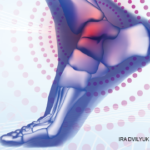Clinical Presentation & Diagnosis
When a patient presents to the rheumatologist’s office with unilateral hip or knee pain related to OA, the provider may choose to screen for LLD, which is suspected to play a role in the development and progression of hip and knee OA. In one cross-sectional study of more than 6,000 people, those with LLD of 20 mm or greater were more likely to have knee symptoms and hip symptoms, although the relationship to hip pain was not statistically significant.2
Similarly, a prospective observational cohort study of more than 3,000 participants showed that radiographic leg-length inequality was associated with prevalent, incident symptomatic and progressive knee OA.3

Dr. Segal
In diagnosing a discrepancy, the first step is to identify whether the difference is functional or structural, says Neil Segal, MD, MS, medical director of musculoskeletal rehabilitation at the University of Kansas Medical Center, Kansas City and a co-author on the cohort study. “The next step would be determining the magnitude of the inequality between the limbs,” he says, noting this can be done initially with a tape measure in the physician’s office and then confirmed with a full-limb radiograph.
During a physical exam, the provider can assess LLD using direct or indirect methods. The direct method involves using a tape measure to quantify limb length between two defined points, whereas indirect methods involve palpating bony landmarks.4
Visual analysis can also be used and is the easiest way to spot a discrepancy. The physician should start by having the patient lie on the exam table, ensuring the patient’s pelvis is flat, and then putting the patient’s legs together. By placing the malleoli of each foot or each leg next to the other, the provider can see whether there appears to be a difference or not.
Manual measurements can’t discern between functional or structural discrepancies, and they tend to be inexact, depending on the provider’s technique and experience.1,4 Accuracy can also be affected by other issues the patient has. Genu valgum deformity of the knee, for example, causes differences in the length of the leg and progression of OA.5

Dr. Lane
Foot height discrepancy can be a significant contributor to LLD, says George Lane, DPM, a podiatrist at Achilles Foot & Ankle Center, Richmond, Va., who developed a novel technique for evaluating foot contribution to LLD.6
“A mild to moderate foot height discrepancy, which is often just a few millimeters, means there are typically significant misalignments within the joints of at least one of the feet,” Dr. Lane explains. “This can not only have a profound damaging effect on the joints of the feet, but also on ligaments, tendons and joints of the lower extremities and back.”

